Service Design (e-government)¶
Paul Klee, "Drehbares Haus", 1921Identifying pain points in service encounters with public administration ( PhD project)¶
Applied methods & measures
UX research methods: ethnographic approaches, field studies, job shadowing, focus groups, qualitative interviews with semi-structured interview guides, personas, scenarios, explorative research with software prototypes
Methods for analyzing data: claims analysis, document analysis, competitive analysis, interview transcription, literature review
Communicating Findings Using: storyboards, use cases, wireframes, presentations, written reports, conference publications
Goal: Identify the information needs of specific populations such as new arrivals in a city, exchange students, taxpayers, and customers of public authorities/organizations. Identify areas of problems in the personal information management or process execution for future e-government solutions (related to the projects Data Purse and Public Administration Advisory Support).
Approach: Semi-structured interviews were carried out with students and administrative staff from the university and the public authorities (registration desk at the city of Zurich, taxation office of the city of Zurich, crime prevention services of the city of Zurich). Our research process and the development process of the prototype were based on the approaches of Scenario-Based Design and Design Science Research (cf. expandable section below).
Moreover, job shadowing and observing public administration staff in real service encounters were used to gather data (registration desk, crime prevention services).
Scenario-Based Design and Design Science Research
Scenario-based design (cf. Rosson & Carroll, 2002) focusses on an in-depth analysis of the current problems and the development of various scenarios for the solution development putting the user's needs in the center of attention.
Scenario-based design process
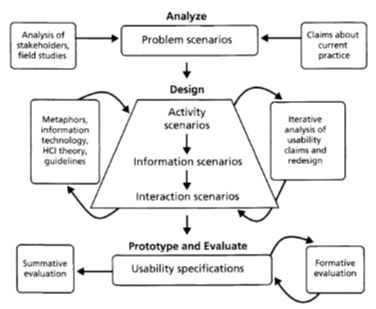
Source: Rosson, M.B. & Carroll, J.M., 2002. Usability engineering: scenario-based development of human-computer interaction, San Francisco etc.: Morgan Kaufmann. Page 25
Design Science Research guides the development of IT artifacts based on informed design-choices and feeding back elaborated knowledge into the scientific/organizational knowledge base. This happens in cycles because products are created iteratively and are improved from cycle to cycle.
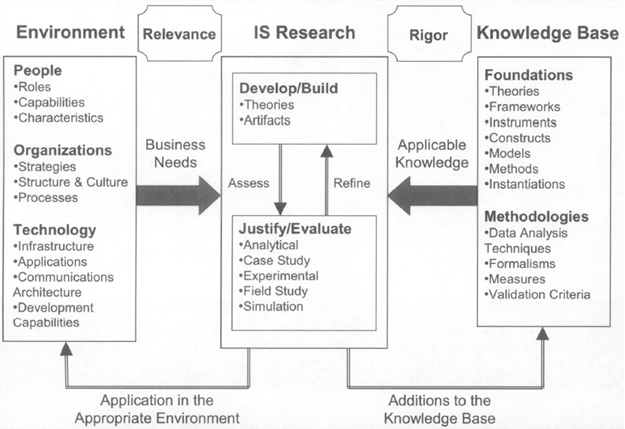
Source: Hevner, A., March, S. T., Park, J., & Ram, S. (2004). Design science in information systems research. MIS quarterly, 28(1), 75-105.
Expert interviews and brainstorming workshops have been carried out to identify current practices and possible future benefits of exchanging data between several stakeholders (e.g., between the IT service provider of the city of Zurich and a private-sector-based insurance company).
Furthermore, document analysis was performed (official documents and artifacts handed to advice-seeking clients by the administrative staff). Literature analysis concerning e-government strategies on the national and local level was performed and relevant information was extracted.
Findings were generated by discussing, identifying topics, claims analysis, card sorting, and adapting an existing software prototype to later carry out evaluations with the improved information architecture (and other software features). Process analysis was carried out to identify the stakeholders, their roles, the process triggers, relevant activities, and which artifacts are used. The processes were visualized using BPMN diagrams.
Findings: The findings were used to improve existing personas and write new problem/information/interaction scenarios which were further grouped as problem scenarios (as-is) and future scenarios (as could be/envisioned). These scenarios were used to discuss, identify, and refine requirements with the project stakeholders. For the domain of crime-prevention services, a storyboard was developed by a fellow PhD-student to communicate the envisioned solution. Based on all these current practices, generic requirements for the envisioned "electronic data safe" were identified. Please see the publications section for details on the findings and results.
Role of Joachim Pfister: Helped to define the research plan, collaborated in discussing the research approach and the elaboration of the interview guides, data collection (workshops, job shadowing, document analysis, and semi-structured interviews), data analysis (business process analysis, BPMN modelling and verification of these models with domain experts, gap analysis to identify challenges and opportunities in the alignment of current practices/processes with overall e-government strategies on a cantonal or national level), and writing and refining scenarios and personas based upon the findings.
UX research challenges successfully addressed
- Desk research for identifying current practices and elaborating initial interview guides.
- Successfully engaged stakeholders by communicating transparently about roles, responsibilities, and the reason for this research.
- Identification of pain points related to several departments of the public administration:
- Advice-giving and taking can benefit from technology support.
- Current processes are optimized with a focus on a specific administrative unit and do not take into account the whole user journey.
Research prototype for student counseling services and welcoming new citizens
Main screen with sticky notes to organize information needs and results
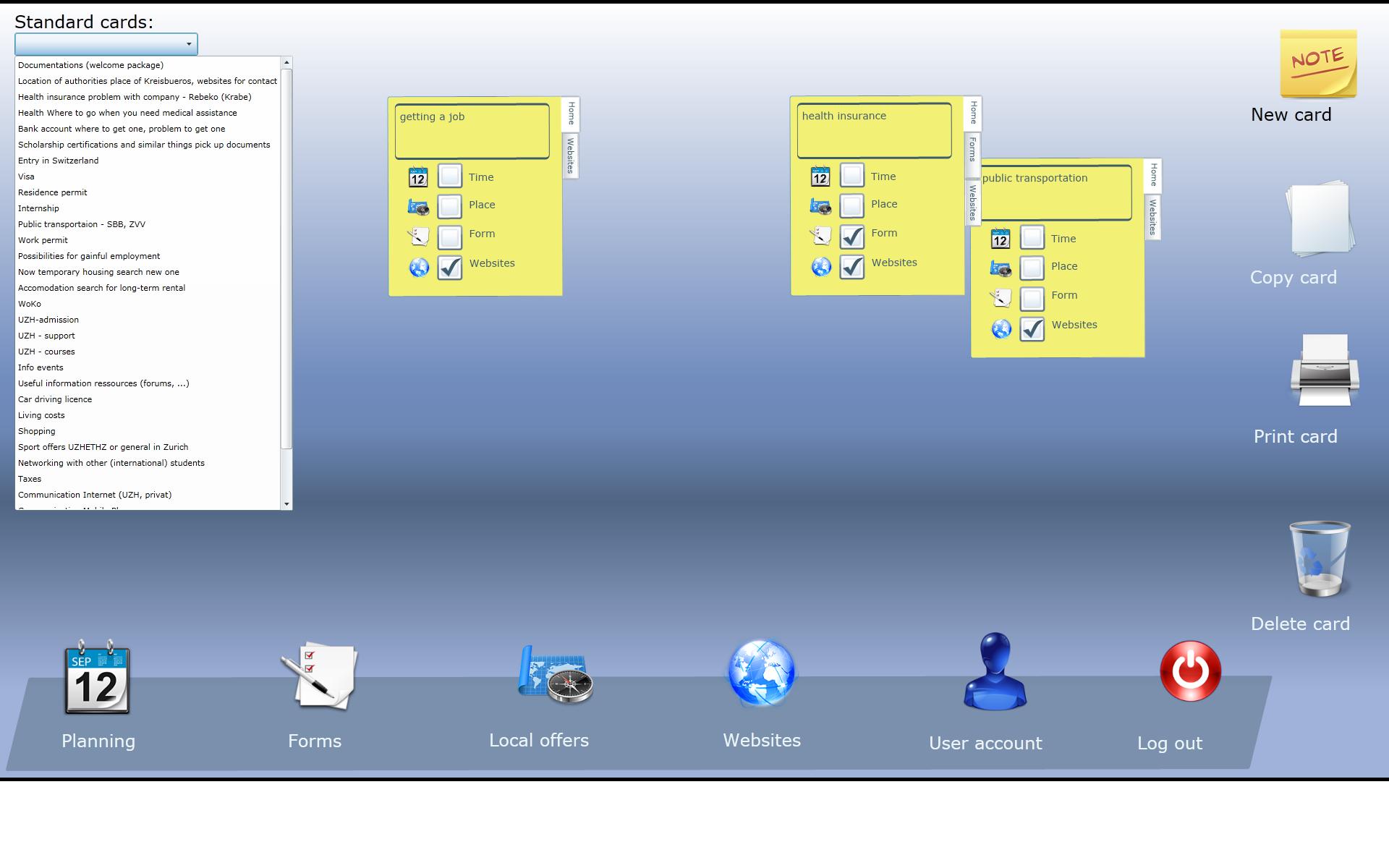
Working on an information need in the prototype.
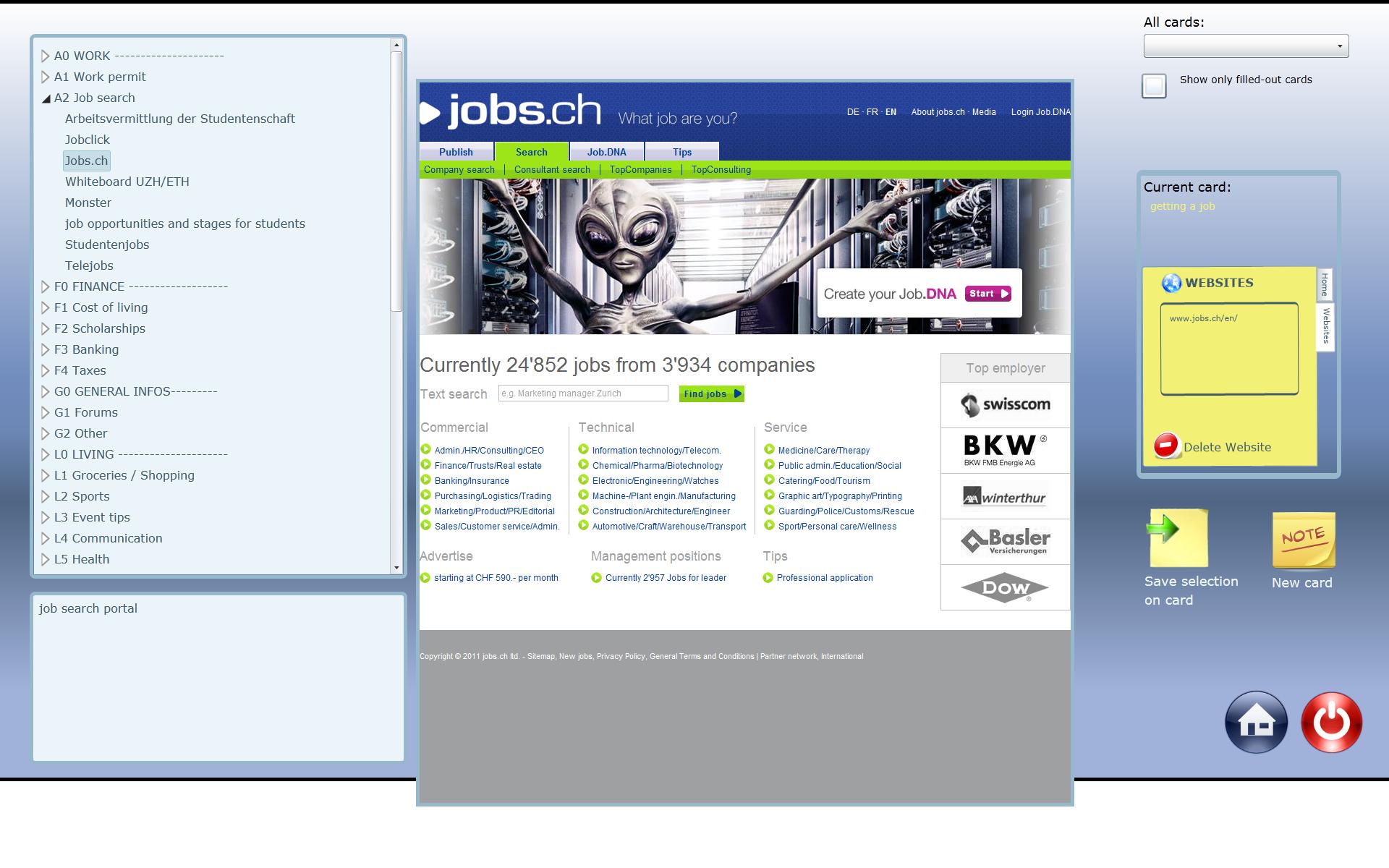
Physical setup of the advice-giving situation

BPMN diagram
Below, you will find a BPMN (Business Process Modelling Notation) diagram of one e-government process and all stakeholders involve. The diagram was part of the project documentation and results documentation.
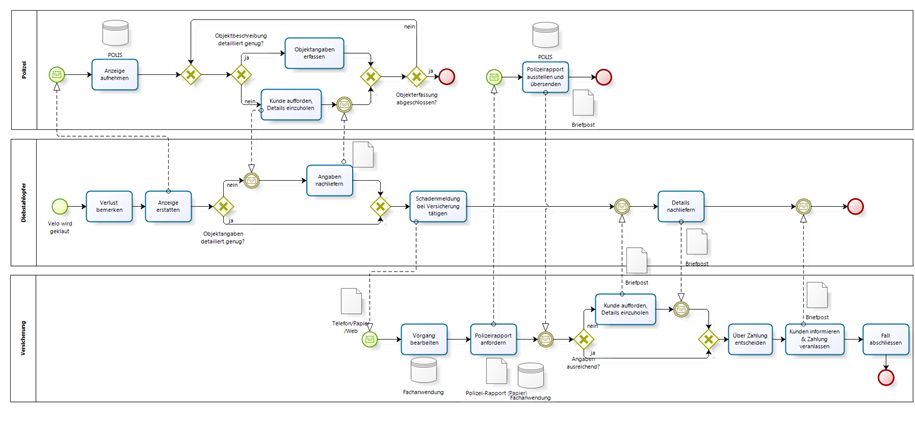
Stakeholder analysis
Analysis of the stakeholders in the Data Purse project (cf. Wikipedia entry on stakeholder analysis).
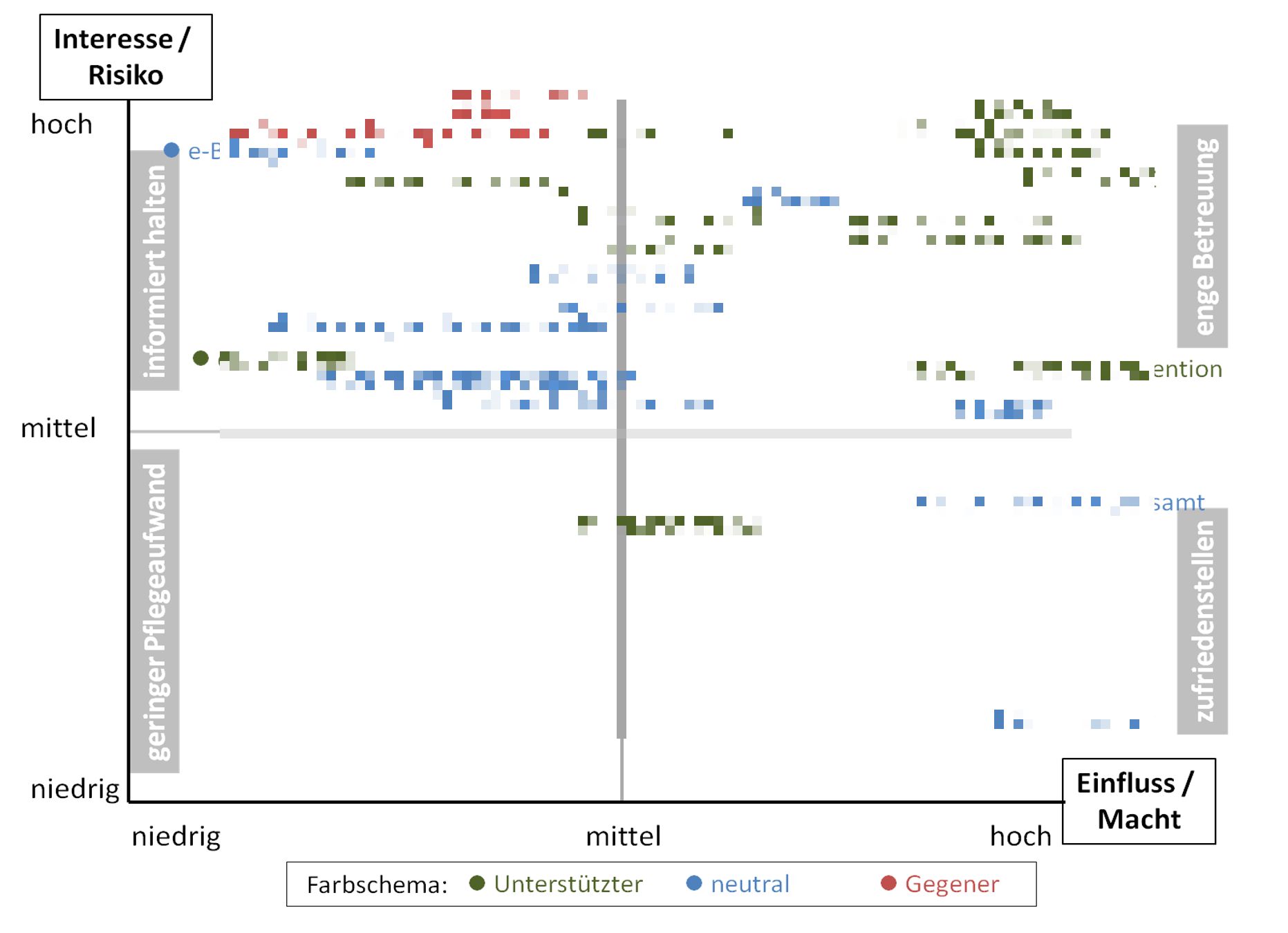
-
Pfister, Joachim (2014): Life-Management-Plattformen als Antwort auf gegenwärtige und zukünftige Nutzerbedürfnisse im E-Government? In: Lück-Schneider, Dagmar; Gordon, Thomas F.; Kaiser, Siegfried; Löhe, Martin; von Lucke, Jörn; Schweighofer, Erich; Wimmer, Maria A. (Eds.): Beiträge zur Verwaltungsinformatik, Fachtagung Verwaltungsinformatik vom 20.-21.03.2014 in Berlin. Hochschule für Wirtschaft und Recht Berlin, Berlin (Beiträge aus dem Fachbereich Allgemeine Verwaltung). pp. 85-96. (PDF online)
Abstract EN:
Are Life-Management Platforms an Answer to current and Future User Needs in E-Government?This article shows potential implications for the design of e-government services based on current user behavior and expectations. It also discusses whether life-management platforms could serve as one possible answer for the challenges that have been surfaced. For this, a narrative literature review is performed in order to identify those challenges: What do people think about e-government services? Which channels are preferred in which life event? What are the reasons for (non-)adoption? Which services are liked by the users who use them? Based on this perspective on current usage, a life-management platform will be presented to address those challenges. Citizens will benefit from such a platform from bundling formerly fragmented transaction services. Value is created by offering potential for synergies for all e-government as well as for e-business stakeholders.
Abstract DE:
Life-Management-Plattformen als Antwort auf gegenwärtige und zukünftige Nutzerbedürfnisse im E-Government?Dieser Beitrag beleuchtet, welche potentiellen Schlüsse aus dem heutigen Nutzungsverhalten und den Nutzererwartungen für die Gestaltung von E-Governmentangeboten gezogen werden können und ob Life-Management-Plattformen eine mögliche Antwort auf die daraus abgeleiteten Herausforderungen geben können. Hierzu werden mit Hilfe eines narrativen Literatur-Reviews folgende Fragestellungen behandelt, um erste Herausforderungen zu identifizieren: Was denken die Bürger über E-Government-Angebote? Welche Kanäle werden in welchen Lebenslagen bevorzugt? Was sind Gründe für die (Nicht-)Nutzung? Welche Services sind bei Nutzern beliebt und wer nutzt sie? Darauf aufbauend wird aus der Perspektive dieses heutigen Nutzungsverhaltens eine LifeManagement-Plattform als mögliche Lösung zur Beantwortung der Herausforderungen vorgestellt. Solch eine Plattform bündelt für den Bürger als Endnutzer die bislang fragmentierten Transaktionsangebote, um sowohl im öffentlichen E-Government- als auch privatwirtschaftlichen E-Business-Bereich durch Synergien Mehrwerte für alle daran beteiligten Anspruchsgruppen zu schaffen.
-
Giesbrecht, Tobias; Pfister, Joachim; Schwabe, Gerhard (2013): Designing IT-support for citizen advisory services: A self-determination theory perspective. e-Service Journal. Vol. 9 (1). pp. 60-84. (PDF online @ institutional repository of University of Zurich)
Abstract: Designing IT-support for citizen advisory services: A self-determination theory perspective
In public advisory services, the individual's satisfaction depends less on extrinsic factors (e.g., monetary rewards) than on their inner needs fulfillment. Currently used IT-systems supporting citizen advisory services neglect these intrinsic needs of their users, hence insufficiently fostering their satisfaction. In this article, we aim to close this gap by assessing the design requirements needed to develop value-added IT-systems supporting citizen advisory services. We argue that previous developments of design requirements for correspondent IT-systems neglect the users' motives and focus merely on their actions. We thus refer to self-determination theory as a theoretical lens to analyze current literature on how to design adequate IT-systems fostering users' basic needs. In doing so, we introduce design goals and demonstrate to what extent they are fulfilled when these design requirements are implemented in a real-world IT-system that supports citizen advisory services. We follow a design science approach, in which the previously elaborated requirements are implemented in a software prototype, and are then evaluated qualitatively in two user studies with real-world advisors and citizens to assess their suitability relative to the design goals. Our results show that this approach promises to reveal the design requirements that matter in citizen counseling, signifying an important step toward developing a conceptual IT systems design theory.
-
Giesbrecht, Tobias; Pfister, Joachim; Schwabe, Gerhard (2012): A self-determination perspective on IT-based citizen advisory support. In: 45th Hawaii International Conference on System Science (HICSS). January 04-07, 2012. Maui, Hawaii, USA. pp. 2501-2510. DOI: 10.1109/HICSS.2012.83. (PDF online @ institutional repository of University of Zurich)
Abstract: A self-determination perspective on IT-based citizen advisory support
In public advisory services, the individual’s satisfaction depends less on extrinsic factors (e.g., monetary rewards) than on their inner needs fulfillment. Currently used IT-systems supporting citizen advisory services neglect these intrinsic needs of their users, hence insufficiently fostering their satisfaction. In this paper, we aim to close this gap by assessing the design requirements needed to develop value-added IT-systems for citizen advisory services. We thus refer to self-determination theory to analyze current literature perspectives on how to design adequate IT-systems fostering users’ basic needs. We follow a design science approach and implement these requirements in a software prototype, and evaluate them qualitatively in a user study with real-world advisors and citizens. Our preliminary results show that this approach promises to reveal the design requirements that matter in citizen counseling, signifying an important step toward developing a conceptual IT systems design model.
